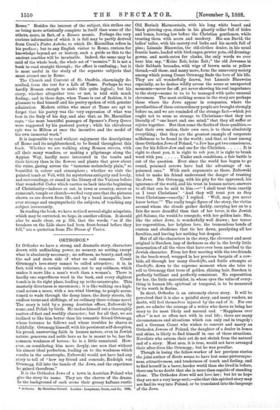ROMAN MOSAICS.*
THERE can be no doubt that this book of Dr. Macmillan's is. appropriately named. It is made, as he says, of " old facts gathered from many sources," and put together harmoniously to form a picture,—or, rather, many pictures, for we have seldom met with a small volume containing a greater variety of scenes and subjects. We have Rome, both ancient and modern, in a hundred aspects. We have picturesque descrip- tion, architecture, natural history, early legend and religion,. folk-lore, miracle, geology, art, superstition, literature, history, biography ; we have stone and marble in all their kinds. and uses, early manuscripts, tombs, volcanoes. The list might be made very much longer ; and in the study of these various objects of interest, we are very far from being restricted to their historyand development in Rome itself, or even in Italy.. The chapter on " The Cumzean Sibyl" takes us at once to Mount, Carmel and the Jewish prophets. That called " Footprints in Rome," beginning in the Church of Domine quo Vadis, on the- Appian Way, where the stone is shown with two footprints upon it, said to be those of Our Lord when he met St. Peter, carries ns on to an account of miraculous footprints all over- the world—Jerusalem, Mecca, Ceylon, India, Scotland, Ireland,. France, Norway, Sweden, Africa, America, the South Sea, Islands—and a full discussion of the subject. In the same way, the most interesting chapter on " Obelisks," beginning in Rome, traces these wonderful works up to their origin in Egypt, and gives the history and description—we are not saying too- much—of every well-known obelisk in the world. Another- study of the same kind, and even more curious, is that on " Holed Stones and Martyr Weights," where the stone of the- Bocca della Yerita and the Lapides Martyrum are only the leaders among a world-wide series of such relics, going on to- the vexed question of jade, and how it came into Europe. And here we must say, though in ignorance, and without any pre- tence of having studied the subject, that it is at first sight easier to believe in Professor Max Miiller's theory of the migration of the Aryans, than in a system of barter, in those early ages, between the dwellers in Switzerland and the dweller in China and India. Such a " link of connection between the- East and the West," to use Dr. Macmillan's own words against the theory supported by him, "indicates a degree of civilisation which we are not accustomed to associate with those primeval' times."
If we were to point out our favourite among these " mosaic, pictures," it would perhaps be " The Marbles of Ancient
• Roman Mosaics; or, Studies in Rome and its Neighbourhood. By Hugh Macmillan, D.D., LL.D., lc. London : Macmillan and Co. 1888. Rome." Besides the interest of the subject, this strikes one as being more artistically complete in itself than some of the others, more, in fact, of a Boman mosaic. Perhaps the very curious information of which it is full may be partly derived from Corsi's Pietre Antiehe, to which Dr. Macmillan refers in his preface ; but to any English visitor to Rome, curious for knowledge beyond art or history, such a guide as this to the ancient marbles will be invaluable. Indeed, the same may be said of the whole book, the whole set of "mosaics." It is not a book to read straight through ; the effect is confusing; but it is most useful in the study of the separate subjects that must attract one in Rome.
The Church and Convent of St. Onofrio, charmingly de- scribed, form the text for a Life of Tasso. Perhaps he was hardly Roman enough to make this quite logical ; but his story, whether altogether true or not, is told with much feeling; and in these days, when Tasso is out of fashion, it is pleasant to find himself and his poetry spoken of with genuine admiration. Modem critics who sneer at Tasso are apt to forget that his poetry was the very expression of what was best in the Italy of his day, and also that, as Dr. Macmillan says, " the most beautiful passages of Spenser's Faery Queen were suggested by his pastoral poetry ; while his chivalrous epic was to Milton at once the incentive and the model of his own immortal work."
It is impossible to read without enjoyment the descriptions of Rome and its neighbourhood, to be found throughout this book. Whether we are walking along Roman streets, with all their many wonders, or making a pilgrimage along the Appian Way, hardly more interested in the tombs and their history than in the flowers and plants that grow about the ruins, gazing across the " immense melancholy plain," so beautiful in colour and atmosphere ; whether we visit the painted tomb at Veii, with its mysterious antiquity and lovely, sad surroundings, or stand in the library of the Vatican before that wonderful Codex which carries us back into the beginning of Christianity—indoors or out, in town or country, street or catacomb, temple or church—we feel very mire that the pictures shown us are drawn from life, and by a hand incapable, how- ever strange and unsympathetic the subjects, of touching any subject irreverently.
In reading the book, we have noticed several slight misprints, which may be corrected, we hope, in another edition. It should also be made clear, on p. 334, that the words, " as if the breakers on the Lido shore had been frost-bound before they fell," are a quotation from The Stones of Venice.



















































 Previous page
Previous page